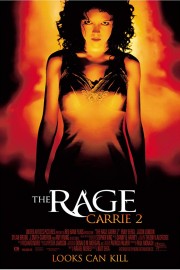The Rage: Carrie 2
I never saw “The Rage: Carrie 2” in 1999. I hadn’t yet seen Brian DePalma’s classic adaptation of the Stephen King novel, and horror was not quite as interesting to me as it is now. But when a friend suggested it for my “Flashback to 1999” series on the podcast, I definitely wanted to give it a fair shake, and check it out for myself. Twenty years removed from its initial release, I think this is a film that both stays surprisingly true to the original film, but also makes some mistakes it didn’t really need to make.
Rafael Moreu’s screenplay plays largely as a retread of the original King story, about a young woman with telekinetic powers who gets revenge on the popular kids at her school who are bullying her, but the film director Katt Shea builds out of that premise feels more potent and honest about the pains of young women in high school than even DePalma’s film, however good it is, does. Rachel Lang (Emily Bergl) may look like a goth kid circa the late ’90s, but the character is richer than simply a cliche- she is intelligent, attractive and has friends; she’s just not part of the “in crowd” of jocks and cheerleaders that populate the high school. She is a foster kid after her mother, Barbara, is institutionalized for schizophrenia when she tries to protect Rachel from “the devil” while Rachel is still a young child, albeit one displaying similar telekinetic powers as Carrie White. But through circumstance, Rachel will find herself around the popular kids more when her best friend, Lisa (Mena Suvari), kills herself, and a disturbing side of high school life shows itself, all the while Rachel gets closer with Jesse (Jason Landon), a football player who seems decent enough, but runs with an ugly group of friends.
When I looked into the film a bit more, I was a bit shocked to find that the genesis of the story came not just from doing a sequel to King’s classic, but took inspiration from a real-life case of high school jocks known as “The Spur Posse,” who chronicled their sexual conquests- including sexual assaults and statutory rape- for sport, and bragging rights. While I was shocked by the real-life inspiration “The Rage” was drawing from, I cannot say I’m surprised that such a case existed for Moreu and Shea to build their supernatural tale off of, because, in the current landscape of #MeToo and #BelieveWomen, where cases like the Steubenville rape trial and Brock Turner shine a light on privilege and the way society views men with bright futures as more important than the women and girls they take advantage of, “The Rage” feels very authentic in its DNA, and is probably more contemporary and vital a piece of pop cinema than many people want to admit. I would even go so far to say that it’s a better updating of the material than Kimberly Pierce’s 2013 adaptation of the original King story, and this is a film worth rediscovering for horror fans, and movie fans, in general.
Having said that, however, “The Rage” makes some mistakes worth taking note of in any discussion of it as a film, and as a continuation of not just King’s story, but a sequel to DePalma’s movie. The film also stars Amy Irving as Sue Snell, who is a guidance counselor at Rachel’s high school. Sue was one of the only survivors from Carrie White’s destruction in DePalma’s film, so when she starts to see signs of Rachel’s supernatural gifts, she gets concerned, and goes to see Rachel’s mother, who shares a key revelation about who Rachel’s father is. That revelation is, in my opinion, the biggest miscalculation the film makes. It’s is an unnecessary connection to the DePalma film to make, and feels like one done for the sole purpose of it being a sequel, as we typically thing of it. I think having Irving’s character having to deal with another telekinetic girl would have been enough. The filmmakers disagreed, and in my opinion, made an interesting follow-up worse, as a result.










